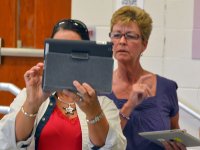A PD Story: Bringing 1:1 Technology to Our District
A district-wide 1:1 roll-out involves aligning PD and program goals, rethinking human resources, personalizing the PD program, and evaluating PD efforts to meet developing needs.
Digital transformation requires more than the introduction of computing devices into the learning environment. It requires a shift in mindset and in the daily practices of school leaders, teachers, and students. In order to support school leaders and teachers to become their most effective at using digital technologies with new pedagogies, it is vital that a district support the digital transformation through varied building-level and district-level professional learning opportunities.
Salisbury Township School District offers a 1:1 digital learning environment for grades K-12. We began our journey in 2006, reached a milestone in 2011 with 1:1 in our middle and high schools, and reached another milestone in 2014 when we became a digital school district. Throughout the past several years, we have worked diligently to implement the following four actions to maximize our professional development implementation.
1. Align PD goals with 1:1 program goals.
Effective digital transformations have articulated goals that reflect the desired changes in teaching and learning. With goals clearly defined, professional development efforts can be fine-tuned. Our current goals are focused on developing transformational learning opportunities with technology as defined by the SAMR framework and Webb's Depth of Knowledge.
2. Rethink use of human resources.
Coupled with expectations for changing teaching and learning came the need to rethink the human and financial resources dedicated to supporting change. We hired computer technicians with expertise in software applications in addition to computer repair. We documented the changing role of the librarian in an updated job description. We also created a new administrative position, Supervisor of Instructional Practice, to coordinate the support mechanisms in the digital transformation. These varied job roles came together in the formation of a support group (we call it TLC) to best identify and support the professional learning needs within each school.
3. Personalize the PD program through differentiation and choice.
Like student learners, adult learners come to the work environment with a variety of knowledge, skills, and backgrounds. Throughout our digital transformation, it has been important to acknowledge that diversity, providing adult learners with personalized options built on the Learn Forward Standards for Professional Learning.
Instructional Technology Cohorts
In the early days of our transformation, professional development took the form of a cohort model over three years. In Cohort 1, the district contracted with an outside vendor to provide eight full professional development days related to software applications, the SAMR framework and challenge-based learning. This professional development provided a balance of learning in regard to applications and pedagogy.
With Cohorts 2 and 3, we looked for experts within the district to share their collective knowledge. While the software technicians taught the apps, our library media teachers supported their sessions by proffering ideas to connect the software with classroom activities. Our administrators presented the SAMR framework, and one of our high school teachers, along with her students, presented challenge-based learning.
Summer Academy
A robust set of professional learning offerings has been provided for professional and support staff as part of Summer Academy. This past summer, there were 40 professional development sessions facilitated by staff members, in both face-to-face and online learning environments. Many of the sessions supported technology/instructional technology and content-specific topics focused on district goals.
Conferences and Workshops
Teachers and administrators are also encouraged to attend conferences and workshops offered outside the district. We have supported attendance and presentations at PETE&C, ISTE, and various Edcamps. We are also involved in the organization of an annual local conference, the Bucks-Lehigh EduSummit, a collaboration of multiple districts including three Project RED Signature Districts.
Learning for School Leaders
Administrators also participate in their own professional learning. The professional learning community for school and district leaders meets monthly in a lunch and learn format. Past topics have included the SAMR model, information literacy skills, Webb's Depth of Knowledge, transitioning to PA Core, and numerous technology tools.
4. Evaluate PD efforts to meet developing needs.
With changes in technology tools, best practices, and state learning initiatives, professional development should be monitored and evaluated to stay relevant. We evaluate our workshops and programs formally through surveys, and informally through reflection and debriefing. We have also created a district-wide walkthrough protocol to help specifically evaluate the effectiveness of our SAMR and DOK professional development.
While we've learned a lot over the years, there is still much work to be done! In our latest efforts to evaluate our PD, we realize that progress toward our 1:1 goals needs to be more systemic. In response to this deficiency, we have developed our most recent PD initiative, Innovate Salisbury. As a part of this professional development, a team of teachers is engaging with building leaders, district leaders, and other experts/thought leaders to help shape the vision for teaching and learning in our classrooms. Innovate Salisbury is a perfect example of how the focus of PD can shift based on the ever-changing needs of a 1:1 digital transformation.
We'd love to hear your PD stories, especially as related to district-wide initiatives and 1:1 programs, in the comments section below.
